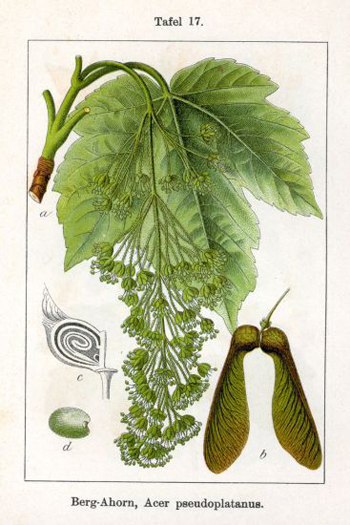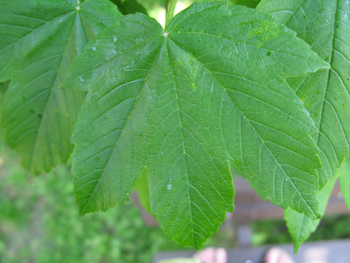Contents:
Common Names | Parts Usually Used | Plant(s) & Culture | Where Found | Medicinal Properties
Legends, Myths and Stories | Uses | Bibliography
Scientific Names

- Acer pseudoplatanus L.
- Maple family
Common Names
- Sycamore Maple
Parts Usually Used
Bark
Back to Top

Description of Plant(s) and Culture
Sycamore maple is a large deciduous tree; it grows as high as 100 feet, and its spreading branches bear opposite, 5 lobed, coarsely crenate-serrate leaves which resemble those of the sycamore tree. The leaves are dark green on top, pale and whitish beneath. The yellowish-green flowers grow in hanging racemes, producing eventually the winged fruit characteristic of the maples.
Back to Top
Where Found
Found in mountainous and upland areas of Europe and western Asia and cultivated to some extent in the United States.
Back to Top
Medicinal Properties
Astringent, vulnerary
Back to Top
Legends, Myths and Stories
This tree has characteristics of the sycamore but it is a maple tree. Sycamore (Platanus occidentalis) grows to 150 feet with bark that is mottled, multi-colored, and peeling. Fruits are globular.
Back to Top
Uses
The bark has mild astringent properties and has been used to make a wash for skin problems and an eyewash for sore eyes. The inner bark of the tree, containing the sweet sap, can be used as dressing for wounds.
Back to Top
Bibliography
![]() American Folk Medicine
American Folk Medicine, by Clarence Meyer, Meyerbooks, publisher, PO Box 427, Glenwood, Illinois 60425, 1973
![]() Culpeper’s Complete Herbal & English Physician: Updated With 117 Modern Herbs
Culpeper’s Complete Herbal & English Physician: Updated With 117 Modern Herbs, by Nicholas Culpeper, Meyerbooks, publisher, PO Box 427, Glenwood, Illinois 60425, 1990, (reprint of 1814)
![]() Eastern/Central Medicinal Plants
Eastern/Central Medicinal Plants, by Steven Foster and James A. Duke., Houghton Mifflin Company, 215 Park Avenue South, New York, NY 10000
![]() The Herb Book
The Herb Book, by John Lust, Bantam Books, 666 Fifth Avenue, New York, NY. copyright 1974.
![]() Indian Herbalogy of North America
Indian Herbalogy of North America, by Alma R. Hutchens, Shambala Publications, Inc., Horticultural Hall, 300 Massachusetts Avenue, Boston, Massachusetts 02115, 1973
![]() Indian Uses of Native Plants
Indian Uses of Native Plants, by Edith Van Allen Murphey, Meyerbooks, publisher, PO Box 427, Glenwood, Illinois 60425, copyright 1958, print 1990
![]() Webster’s New World Dictionary
Webster’s New World Dictionary, Third College Edition, Victoria Neufeldt, Editor in Chief, New World Dictionaries: A Division of Simon & Schuster, Inc., 15 Columbus Circle, New York, NY 10023
 The Rodale Herb Book: How to Use, Grow, and Buy Nature’s Miracle Plants (An Organic gardening and farming book)
The Rodale Herb Book: How to Use, Grow, and Buy Nature’s Miracle Plants (An Organic gardening and farming book), edited by William H. Hylton, Rodale Press, Inc. Emmaus, PA, 18049., 1974
